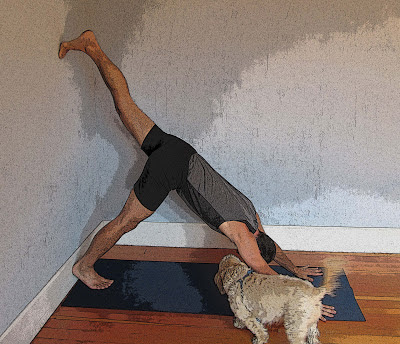by Nina
 |
| Practicing with a Friend by Nina Zolotow |
Most of us start doing yoga in a class, and those classes are relatively long, usually ranging from one to two hours. So we often get the idea that practicing at home means doing the equivalent of a full-length class. Finding the time and/or energy to do that can be overwhelming, preventing us from ever getting started.
But all of us here at Yoga for Healthy Aging believe that even doing a single pose constitutes a yoga practice, and we strongly encourage anyone who wants to get started with a home practice, to go ahead and start small! You’ll probably find that if you’ve bothered to change into your yoga clothes and get out your mat, and you’ve done your single yoga pose, you’ll feel ready to add on a few more poses. You’re not ready for a full-length practice, but you definitely feel up to a well-rounded “mini” practice that is, say, about 15 or 20 minutes long. But how do you decide what poses, and in which order you should do them for your mini practice?
Of course you could ask your favorite yoga teacher for some suggestions, but, although there is definitely an art to creating a sequence of yoga poses—especially one where you are preparing yourself to take on some challenging pose—you can also start very simply on your own, especially for a short sequence. Here are a few simple guidelines:
1. Ask yourself: what class of poses do I want to today: backbends, twists, forward bends, or inverted poses? Pick one of these general categories to counteract what you’ve been doing lately or what you did yesterday in class, or just because you’re in that kind of mood.
2. Pick an appropriate warm-up pose or two for that category of poses to start the sequence (see Warming Up for information).
3. Choose a few standing poses or a few Sun Salutations that incorporate elements of the category of poses you’ve chosen. Some ideas:
- For backbends: Sun Salutations, or Warrior 1, 2, and 3, Tree pose, Eagle pose
- For twists: Sun Salutations, or Triangle pose, Extended Side Angle pose, Half Moon pose and the revolved versions of all three
- For forward bends: Downward-Facing Dog, Standing Forward Bend, Wide Angle Standing Forward Bend, Triangle pose, Extended Side Angle pose, Half Moon pose, Pyramid pose (Parsvottanasana)
- For inversions: Downward-Facing Dog, Standing Forward Bend, Wide Angle Standing Forward Bend.
4. Pick a few of the poses from your category, starting with the easiest first: easy backbends, seated twists, seated forward bends, or Headstand followed by Shoulderstand, Plow pose, Bridge pose, or Legs Up the Wall pose (skip Headstand if you don’t do it).
5. Select a counter pose to balance your practice. After doing backbends, it’s helpful to do a twist, leg stretch or another back releasing pose. After doing forward bends or twists, I recommend doing a gentle back bend to restore the natural curve to your spine.
6. End with Relaxation pose (Savasana) or another symmetrical restorative pose.
I’ve including standing poses and/or Sun Salutations in all the mini sequences because most of us tend to be sedentary at work, but if you’re on your feet all the time during the day, feel free to skip the standing poses and just add more warm-ups or more poses from your category. Don’t over-think it! Just have fun getting started with your home practice. You’ll be surprised at how rewarding it is. As a matter of fact, Timothy McCall will be writing post for the near future about how much more valuable a home practice is than just going to classes (see Home Practice: The Best Way to Improve Your Health and Well-Being).
Follow Yoga for Healthy Aging on Facebook ° To order Yoga for Healthy Aging: A Guide to Lifelong Well-Being, go to Amazon, Shambhala, Indie Bound or your local bookstore.


Love it!
Thanks!
Gaileee
Having a home practice 5 days a week is a requirement for the yoga teacher training program I'm currently enrolled in. I've found the home practice to be the best part. I get to customize my practice to what I like and what I need. You take everything you learn in class and incorporate into your home practice. It's still important to go to class to learn about alignment especially and get new ideas.
I have used mini sessions for years … 15 min at lunch to fit in some inversion poses, spinal twists and shoulder releases. Now with chronic fatigue as part of PPS I use 20-30 yoga session on days I don't take a class .. sometimes it will be mostly restorative but other days it will be sun salutation or other more active poses. I highly recommend mini sessions for those with chronic illnesses, or recuperating from injuries or surgery.
Awaiting hip replacement surgery. But I have osteoarthritis so don't want to stiffen up in the rest of my body, or even the hip/legs, so a home practice it is. I have learned to be very gentle at this time especially, and find the yoga I end up doing is really relaxing and leaves me with good energy.
SSue